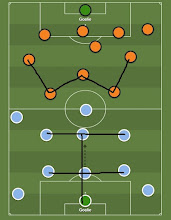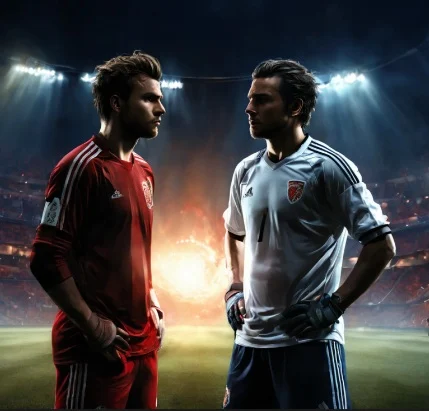The role of sweeper-keeper in modern football
owes its existence to these two underrated shot-stoppers from the past.
Football today
requires a nontraditional role in every position, including goalkeeper. The
days of goalies passively waiting for the ball and not actively participating
in the attacking phase are long gone, particularly at the highest levels.
Classic goalkeepers may still thrive in mid- or low-level teams and
competition, but they certainly will not survive at the elite.
Many have wondered
how Germany’s Manuel Neuer or Manchester City's Ederson rolled out of the
backline to engage in the attacking build-up and serve as an extra defender in
recent years. In the past, the world was astounded by the impressive
goalscoring record of former Sao Paulo star Rugerio Ceni, the unexpected set
piece goals of Paraguayan legend Jose Luis Chilavert, or the ‘lunatic act’ of
Colombia’s René Higuita between the sticks in the 1990s.
Those names could be
those who made their mark on modern football as the sweeper-keeper or the
eccentric goalie. However, they are not the first to take on such a role. In
fact, it existed a long time ago, specifically in the 1950s. These two figures
below were the first, in their own way. They were so ahead of their time that
their work as a shot-stopper was underappreciated or, worse, harshly
criticised.
Gyula Grosics
His name may not be familiar, but he was a
member of Hungary's national team during its golden era in the 1950s. The
Mighty Magyar was the best team of the early decade. They won a gold medal at
the 1952 Olympics and were the first team outside the British Isles to
humiliate England 6-3 at Wembley Stadium before, surprisingly, losing 3-2 to
West Germany in the 1954 FIFA World Cup.
Grosics was the mainstay in the Mighty Magyar
and named in the 1954 World Cup all-stars as well. The former Budapest Honvedman was assigned as ‘the fourth back’ in the defence line due to therevolutionary tactics of his boss in the national team, Gusztáv Sebes. In his
so-called ‘Socialist Football’, Grosics was not excluded from the outfield
players’ task. Everyone must be involved of defence and attack. Such was later
adopted by the Netherlands in their famous Total Football.
Here’s what Grosics notably excelled at, which
inspired the role of sweeper-keeper:
- Moving
out of the penalty box to tackle the attackers from the opposition sides
when necessary.
- Reading
the game from the backline to help the build-up.
- Distributing
the ball with his feet to slowly initiate the attack.
Despite his advanced role, the goalie with 86
international caps seemed to be unable to replicate the success once Sebes
parted ways in 1956. Hungary was no longer as fearful as it once was, and the
role of the Grosics had become somewhat forgotten in their homeland.
The goalkeeper, who used to study to be a priest
before switching to football, still played for Magyar in the 1958 and 1962
World Cups. Unfortunately, they were unable to go through the knockout stage
and semifinals, respectively. Grosics then retired in 1962 with Tatabányai SC serving
as his last club as well as the first one in his brief managerial career in the
following year. The club, which currently competes in the Hungarian third-tier
league, named its stadium after him in 2011.
Amadeo Carizzo
Unlike his European counterpart, who took on the
sweeper-keeper role as a result of his manager's strategy, Carizzo created such
an extraordinary role on his own. He is regarded as the father of the
'eccentric custodian,' also known as 'El Loco,' the South American version of
sweeper-keeper.
Still, he was more than that. In fact, the
goalkeeper known as 'La Maquina' was the first to use the techniques that
modern goalkeepers employ. Here’s what Carizzo contributed to revolutionising
the man between the sticks.
- Dribbling
the ball to leave the penalty box
- Organising
the defensive line actively
- Initiating
a quick attack from the goal kick
- An
unorthodox move to save or deny the shots
- Feigning
an offside call to trick the opponents
- Throwing
the ball with one arm only
- The
first one to wear gloves
Such qualities,
including mind games and unusual technique, have undoubtedly inspired the likes
of Hugo Gatti, René Higuita, Jose Luis Chilavert, and perhaps Emiliano Martinez
too. It has been the distinguishing feature of El Loco goalkeepers, which may
only be well-credited in South America, where eccentricity and creativity are
welcome to collide.
However, in terms of
silverware, Carrizzo had won less than his successors. He did lift the Argentina
league title seven times with River Plate in 1945, 1947, 1952, 1953, 1955-1957,
with his first two not as the team’s number one shot-stopper. Unfortunately, he
was unable to help them clinch the Copa Libertadores title in 1966, as they
lost to Uruguay’s Penarol.
His appearance on the
international stage was even far from impressive. He did not win a single
trophy for Argentina. In fact, he was only capped 20 times, making his debut at
the age of 28 in 1954, and is notoriously remembered for conceding six goals
against Czechoslovakia in the 1958 World Cup. He was even treated unfairly and
blamed by the fans for their 6-1 loss, which is Albiceleste’s worst defeat to
date in their world cup history.
After he hung his
gloves in 1970, Carizzo did attempt to be a manager. Sadly, it was only
short-lived since it ended in the same year as he started, in 1973. He was able
to lead Deportivo Armenio to the fourth tier of the Argentine league system but
failed while taking charge of Colombia’s Once Caldas in the top flight.



Comments
Post a Comment